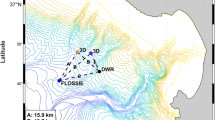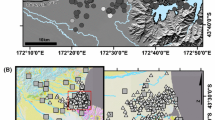Abstract
Undersampled records are susceptible to aliasing, in which a high frequency appears incorrectly as a lower one. We study the sampling requirements in a core taken from Rockall Trough using bulk density, P-wave velocity, and magnetic susceptibility as measured on an automated system. At 2-cm spacing (approximately 33 years in this core), all variables show a characteristic red-noise behavior, but with a spectral slope that is sufficiently weak so that significant aliasing appears to be present. P-wave velocity shows the largest potential corruption, probably owing to the weaker spatial averaging present in the sensor. Approximately 50% of the apparent low-frequency energy is aliased in all variables at some frequencies in both quiet and active regions of the record. In this core, a sampling interval of 0.2 cm appears to be "safe" in both active and quiet portions of the core, aliasing little or no energy, except in the P-wave record. For cores of different duration, sampling interval, and measurement type, the considerations will be identical, the importance of the problem depending directly upon the shape of the overall spectrum describing the entire frequency (wavenumber) range of physical variability.










Similar content being viewed by others
References
Bendat JS, Piersol AG (1986) Random data: analysis and measurement procedures, revised edn. Wiley-Interscience, New York
Bomar BW (1998) Finite wordlength effects. In: The digital signal processing handbook. CRC Press, Boca Raton, pp 3-1–3-18
Dearing J (1999) Environmental magnetic susceptibility. Using the Bartington MS2 system. Chi Publishing, Kenilworth, UK
Gunn DE, Best AI (1998) A new automated nondestructive system for high resolution multi-sensor core logging of open sediment cores. Geo-Mar Lett 18:70–77
Knutz PC, Austin WEN, Jones EJW (2001) Millennial-scale depositional cycles related to British Ice Sheet variability and North Atlantic paleocirculation since 45 kyr B.P., Barra Fan, U.K. Margin. Paleoceanography 16:53–64
Pisias N, Mix A (1988) Aliasing of the geologic record and the search for long-period Milankovitch cycles. Paleoceanography 3:613–619
Priestley MB (1982) Spectral analysis and time series. Vol 1, univariate series. Vol 2, multivariate series, prediction and control. Academic Press, London
Wunsch C (2000) On sharp spectral lines in the climate record and the millennial peak. Paleoceanography 15:417–424
Wunsch C (2003) The spectral description of climate change including the 100 ka energy. Climate Dyn DOI 10.1007/s00382-002-0279-z
Acknowledgements
This work was begun while C. Wunsch was a visitor at the Southampton Oceanography Centre and at University College, London. Thanks are owed to E.J.W. Jones for stimulating this study. P. Huybers made some helpful comments.
Author information
Authors and Affiliations
Corresponding author
Rights and permissions
About this article
Cite this article
Wunsch, C., Gunn, D.E. A densely sampled core and climate variable aliasing. Geo-Mar Lett 23, 64–71 (2003). https://doi.org/10.1007/s00367-003-0125-2
Received:
Accepted:
Published:
Issue Date:
DOI: https://doi.org/10.1007/s00367-003-0125-2




